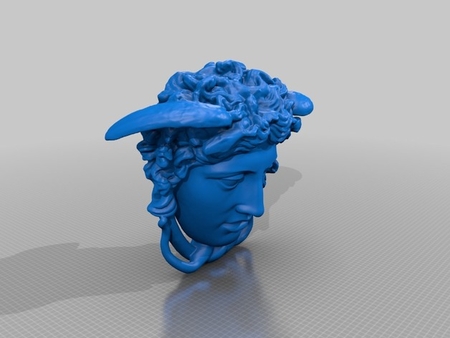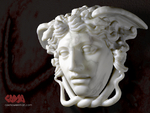The medusa rondanini 3D for print
3606 Views 2 Likes 7 Downloads Download the piece here from 3dforprint
This is my laser scan of the
Skulpturhalle Basel's
plaster cast of the Munich Glyptothek's
Medusa Rondanini
, possibly a fifth-century BC work, and the
oldest-known
"beautiful gorgoneion" sculpture. The design may have been copied from a gilded bronze aegis that once hung in the Acropolis, where it would have been meant to ward off evil and bad luck.
A revision of the
grotesque
, disk-shaped death masks of older gorgoneia, the Medusa Rondanini appears to borrow the idealized likeness of
Athena of Velletri
, wreathed in decorative snakes and delicate owl wings—Chthonic dread and death mixed with Olympian beauty and cunning.
While on display in the Palazzo Rondanini in Rome, it was noticed and first brought to the attention of Northern European art connoisseurs in the 1780s by Johann Wolfgang von Goethe, who
wrote
, "I would say something about it if everything one could say about such a work were not a waste of breath."
—Cosmo Wenman
@CosmoWenman
cosmowenman.com
cosmo.wenman@gmail.com
I captured this work as part of my project, Through A Scanner, Skulpturhalle. You can see the rest of the results at
thingiverse.com/thing:83781
Print upside down, with supports.
Medusa Rondanini
Skulpturhalle Basel accession number 140
Medusa Rondanini. Kopie nach dem Gorgoneion auf dem Schild der Athena Promachos des Pheidias (Buschor) oder Kresilas (Furtwängler)? Das Schildrelief müsste dann später als die Statue (46o/45o v. Chr.) vollendet sein: nach der überlieferung wurde es von dem Maler Parrhasios entworfen. München, Glyptothek. Lippold 173.
Plaster cast molded from the Munich Glyptothek's marble Medusa Rondanini, with reconstructions.
Scanned with a
FARO
Edge Arm with V4 Laser Line Probe at 0.5mm line space with 0.035mm precision, September, 2013.
Mesh holes in laser shadow regions were repaired with [Blender](
http://www.blender.org/
).
470mm wide
2.26 million triangles before editing.
Thanks to the [Skulpturhalle Basel](
http://www.skulpturhalle.ch/
) museum.
Thanks to
FARO
and FARO's Daniel Mazzolini and Thomas Weinert for making laser scanning equipment available to me.
Thanks to Chris Bartschat and Florian Fünfschilling for their expertise and for operating the laser.
And thanks to Autodesk’s
Reality Capture
division, who sponsored this project.
Designer
cosmowenman3d model description
"[T]he mere knowledge that such a work could be created and still exists in the world makes me feel twice the person I was ... If I can get hold of a ...good cast of this Medusa, I shall bring it back with me..."—Goethe, Italian JourneyThis is my laser scan of the
Skulpturhalle Basel's
plaster cast of the Munich Glyptothek's
Medusa Rondanini
, possibly a fifth-century BC work, and the
oldest-known
"beautiful gorgoneion" sculpture. The design may have been copied from a gilded bronze aegis that once hung in the Acropolis, where it would have been meant to ward off evil and bad luck.
A revision of the
grotesque
, disk-shaped death masks of older gorgoneia, the Medusa Rondanini appears to borrow the idealized likeness of
Athena of Velletri
, wreathed in decorative snakes and delicate owl wings—Chthonic dread and death mixed with Olympian beauty and cunning.
While on display in the Palazzo Rondanini in Rome, it was noticed and first brought to the attention of Northern European art connoisseurs in the 1780s by Johann Wolfgang von Goethe, who
wrote
, "I would say something about it if everything one could say about such a work were not a waste of breath."
—Cosmo Wenman
@CosmoWenman
cosmowenman.com
cosmo.wenman@gmail.com
I captured this work as part of my project, Through A Scanner, Skulpturhalle. You can see the rest of the results at
thingiverse.com/thing:83781
Print upside down, with supports.
Medusa Rondanini
Skulpturhalle Basel accession number 140
Medusa Rondanini. Kopie nach dem Gorgoneion auf dem Schild der Athena Promachos des Pheidias (Buschor) oder Kresilas (Furtwängler)? Das Schildrelief müsste dann später als die Statue (46o/45o v. Chr.) vollendet sein: nach der überlieferung wurde es von dem Maler Parrhasios entworfen. München, Glyptothek. Lippold 173.
Plaster cast molded from the Munich Glyptothek's marble Medusa Rondanini, with reconstructions.
Scanned with a
FARO
Edge Arm with V4 Laser Line Probe at 0.5mm line space with 0.035mm precision, September, 2013.
Mesh holes in laser shadow regions were repaired with [Blender](
http://www.blender.org/
).
470mm wide
2.26 million triangles before editing.
Thanks to the [Skulpturhalle Basel](
http://www.skulpturhalle.ch/
) museum.
Thanks to
FARO
and FARO's Daniel Mazzolini and Thomas Weinert for making laser scanning equipment available to me.
Thanks to Chris Bartschat and Florian Fünfschilling for their expertise and for operating the laser.
And thanks to Autodesk’s
Reality Capture
division, who sponsored this project.


